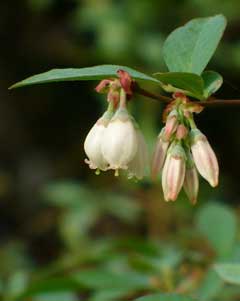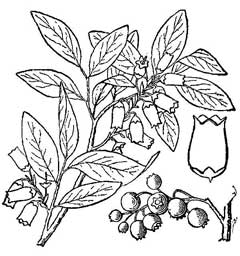 |
|
©Jeff McMillian. USDA Plant Database |
 |
| Britton, N.L., and A. Brown. 1913. An illustrated flora of the northern United States, Canada and the British Possessions. 3 vols. Charles Scribner's Sons, New York. Vol. 2: 700. Courtesy of Kentucky |
Translate this page:
Summary
An excellent blueberry species with large fruit and good autumn foliage best suited to cooler climates. Leave the fruit on the shrub until the last minute, as the fruit is very acidic and will not ripen after being picked. When ripe they make an excellent berry for cooking or eating fresh. Bloom Color: White. Main Bloom Time: Early spring, Late spring, Mid spring. Form: Rounded.
Physical Characteristics

 Vaccinium corymbosum is a deciduous Shrub growing to 2 m (6ft) by 2 m (6ft) at a medium rate.
Vaccinium corymbosum is a deciduous Shrub growing to 2 m (6ft) by 2 m (6ft) at a medium rate.
See above for USDA hardiness. It is hardy to UK zone 2. It is in flower from May to June, and the seeds ripen in August. The species is hermaphrodite (has both male and female organs) and is pollinated by Bees. The plant is not self-fertile.
Suitable for: light (sandy) and medium (loamy) soils and prefers well-drained soil. Suitable pH: mildly acid soils and can grow in very acid soils.
It can grow in semi-shade (light woodland) or no shade. It prefers moist soil.
UK Hardiness Map
US Hardiness Map
Synonyms
Plant Habitats
Woodland Garden Sunny Edge; Dappled Shade;
Edible Uses
Edible Parts: Fruit Leaves
Edible Uses: Tea
Fruit - raw or cooked[2, 3, 43, 62, 161]. It is usually sweet and juicy, though the flavour can be variable[11]. It can be used in pies, pastries, cereals, jellies etc[183]. The fruit can also be dried and used like raisins[183]. The fruit is rich in vitamin C[201]. The fruit is about 15mm in diameter[200]. A tea is made from the leaves and dried fruit[101].
References More on Edible Uses
Medicinal Uses
Plants For A Future can not take any responsibility for any adverse effects from the use of plants. Always seek advice from a professional before using a plant medicinally.
Astringent Pectoral Vitamin C
Astringent, pectoral[201].
References More on Medicinal Uses
The Bookshop: Edible Plant Books
Our Latest books on Perennial Plants For Food Forests and Permaculture Gardens in paperback or digital formats.

Edible Tropical Plants
Food Forest Plants for Hotter Conditions: 250+ Plants For Tropical Food Forests & Permaculture Gardens.
More

Edible Temperate Plants
Plants for Your Food Forest: 500 Plants for Temperate Food Forests & Permaculture Gardens.
More

More Books
PFAF have eight books available in paperback and digital formats. Browse the shop for more information.
Shop Now
Other Uses
References More on Other Uses
Cultivation details
Landscape Uses: Border, Massing, Seashore. Requires a moist but freely-draining lime free soil, preferring one that is rich in peat or a light loamy soil with added leaf-mould[11, 200]. Prefers a very acid soil with a pH in the range of 4.5 to 6, plants soon become chlorotic when lime is present. Succeeds in full sun or light shade though it fruits better in a sunny position[200]. Requires shelter from strong winds[200]. Hardy to about -25°c[184]. Often cultivated for its edible fruit in America[183], it is the most common and successful blueberry to be cultivated in Britain[11]. There are many named varieties[183]. A very variable plant, it usually blossoms freely in Britain[11]. Plants are at least partially self-sterile, more than one variety is required in order to obtain good yields of fruit[182]. Dislikes root disturbance, plants are best grown in pots until being planted out in their permanent positions[200]. leave the fruit on the shrub until the last minute, as the fruit is very acidic and will not ripen after being picked. Does not grow well with blackberries or raspberries[201]. Closely related to V. atrococcum and V. virgatum[182]. Plants in this genus are notably resistant to honey fungus[200]. Special Features:Attracts birds, North American native, Edible, Wetlands plant, Attracts butterflies, Attractive flowers or blooms. The plant is heat tolerant in zones 7 through 1. (Plant Hardiness Zones show how well plants withstand cold winter temperatures.
Plant Heat Zones show when plants would start suffering from the heat.
The Plant Heat Zone map is based on the number of "heat days" experienced in a given area where the temperature climbs to over 86 degrees F (30°C).
At this temperature, many plants begin to suffer physiological damage. Heat Zones range from 1 (no heat days) to 12 (210 or more heat days).
For example Heat Zone. 11-1 indicates that the plant is heat tolerant in zones 11 through 1.) For polyculture design as well as the above-ground architecture (form - tree, shrub etc. and size shown above) information on the habit and root pattern is also useful and given here if available. The plant growth habit is multistemmed with multiple stems from the crown [1-2]. The root pattern is flat with shallow roots forming a plate near the soil surface [1-2]. The root pattern is stoloniferous rooting from creeping stems above the ground [1-2].
References Carbon Farming Information and Carbon Sequestration Information
Temperature Converter
Type a value in the Celsius field to convert the value to Fahrenheit:
Fahrenheit:
The PFAF Bookshop
Plants For A Future have a number of books available in paperback and digital form. Book titles include Edible Plants, Edible Perennials, Edible Trees,Edible Shrubs, Woodland Gardening, and Temperate Food Forest Plants. Our new book is Food Forest Plants For Hotter Conditions (Tropical and Sub-Tropical).
Shop Now
Plant Propagation
Seed - sow late winter in a greenhouse in a lime-free potting mix and only just cover the seed[78]. Stored seed might require a period of up to 3 months cold stratification[113]. Another report says that it is best to sow the seed in a greenhouse as soon as it is ripe[200]. Once they are about 5cm tall, prick the seedlings out into individual pots and grow them on in a lightly shaded position in the greenhouse for at least their first winter. Plant them out into their permanent positions in late spring or early summer, after the last expected frosts. Cuttings of greenwood, May/June in a shady position in a compost that contains some peat[113]. Cuttings of half-ripe wood, 5 - 8cm with a heel, August in a frame[78]. Slow and difficult. Cuttings of mature wood, harvested in November and stored in a fridge then planted in a frame in March. Layering in late summer or early autumn[78]. Another report says that spring is the best time to layer[200]. Takes 18 months[78]. Division of suckers in spring or early autumn[113].
Other Names
If available other names are mentioned here
Blue rose tree, Bluerose
Native Range
NORTHERN AMERICA: Canada, Québec (south), Nova Scotia, Ontario (south), New Brunswick, United States, Connecticut, Indiana (north), Maine, Massachusetts, Michigan, New Hampshire, New Jersey, New York, Ohio, Pennsylvania, Rhode Island, Vermont, West Virginia, Illinois (north), Missouri, Oklahoma, Wisconsin, Alabama, Arkansas, Delaware, Florida, Georgia, Kentucky (east), Louisiana, Maryland (west), Mississippi, North Carolina (west), South Carolina, Tennessee, Virginia (west), Texas,
Weed Potential
Right plant wrong place. We are currently updating this section.
Please note that a plant may be invasive in one area but may not in your area so it's worth checking.
Conservation Status
IUCN Red List of Threatened Plants Status :

Growth: S = slow M = medium F = fast. Soil: L = light (sandy) M = medium H = heavy (clay). pH: A = acid N = neutral B = basic (alkaline). Shade: F = full shade S = semi-shade N = no shade. Moisture: D = dry M = Moist We = wet Wa = water.
Now available:
Food Forest Plants for Mediterranean Conditions
350+ Perennial Plants For Mediterranean and Drier Food Forests and Permaculture Gardens.
[Paperback and eBook]
This is the third in Plants For A Future's series of plant guides for food forests tailored to
specific climate zones. Following volumes on temperate and tropical ecosystems, this book focuses
on species suited to Mediterranean conditions—regions with hot, dry summers and cool, wet winters,
often facing the added challenge of climate change.
Read More
Expert comment
Author
L.
Botanical References
1143200
Links / References
For a list of references used on this page please go here
Readers comment
© 2010, Plants For A Future. Plants For A Future is a charitable company limited by guarantee, registered in England and Wales. Charity No. 1057719, Company No. 3204567.